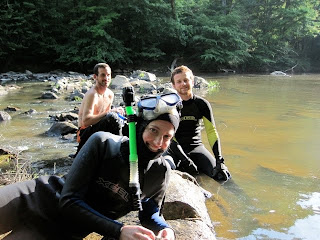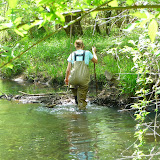Most of my day is spent dredging the bottom of the Apalachicola and Chipola Rivers for mussels. This is a hard feat to accomplish in 2m (6ft) of water with 15 lbs of weight on and a snorkel. Timing is everything. The bottom of the river at 2m is a low visibility murky place with soft mud and steep banks. The other day when I was diving down everything went dark, I mean pitch dark..... and you wonder hmmm.... is that just the cloud of silt I kicked up from the bottom of the river blocking out the sun..... or is there a very large reptile/fish above me. Turns out it was silt and the sun attempted to shine through the murky water down to me once again. Most people think we are crazy.... which some days I wonder if I am (especially when you've been in the field for almost a month straight). But, I love my job, career, hobby, past-time..... Whatever it is, I love it. I am challenged everyday. Some days it's mental, some days it's physical, and on the hard days it's both. Those are the days I fall asleep in bed at 8:30 trying to text my friends back "Yes, I'm okay". Some days are just plain amazing. Take a look for yourself.
And on the bad days.... there is always the float houses to cheer you up. So, this portion of the blog is dedicated to the amazing float houses of the Apalachicola and Chipola Rivers.













